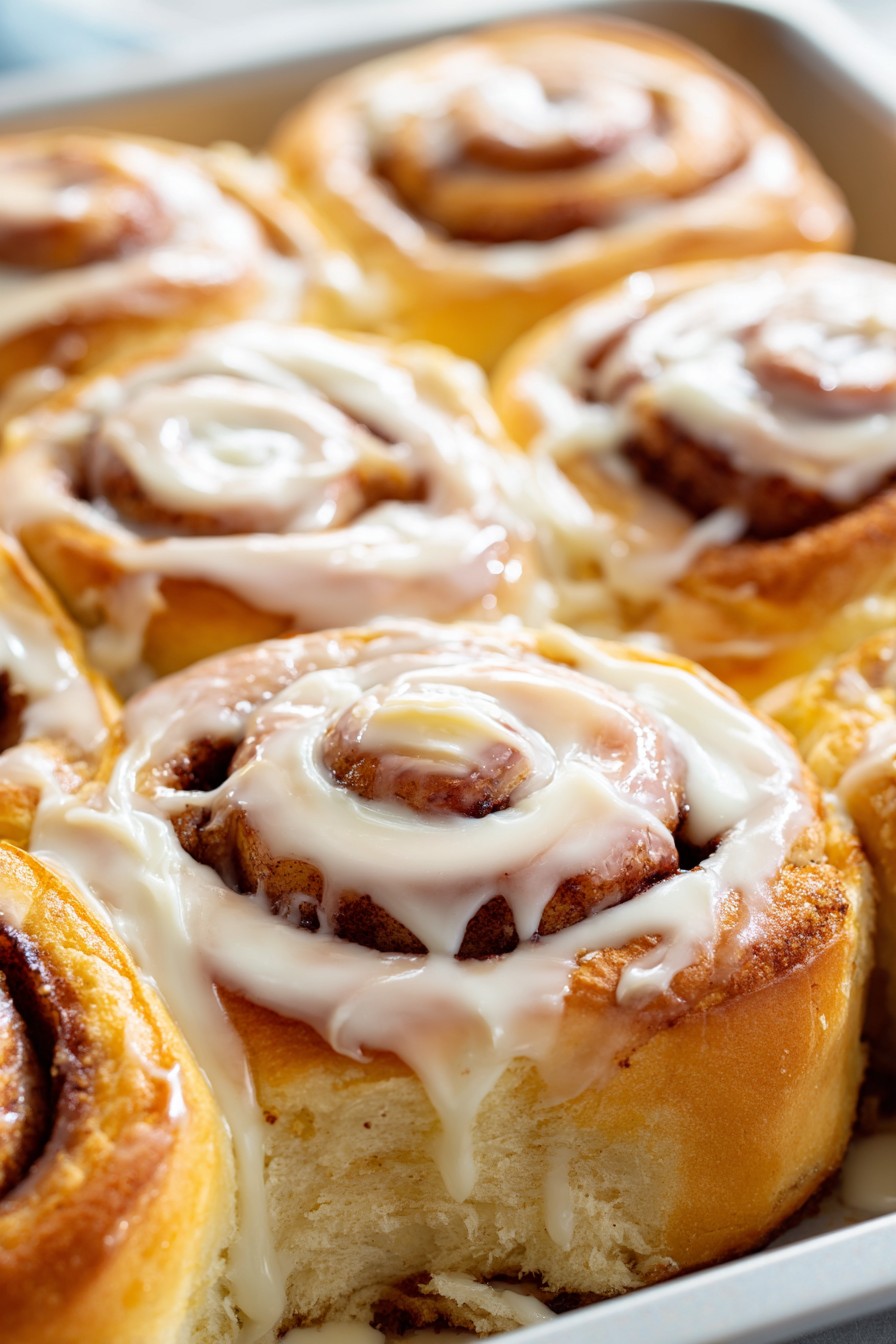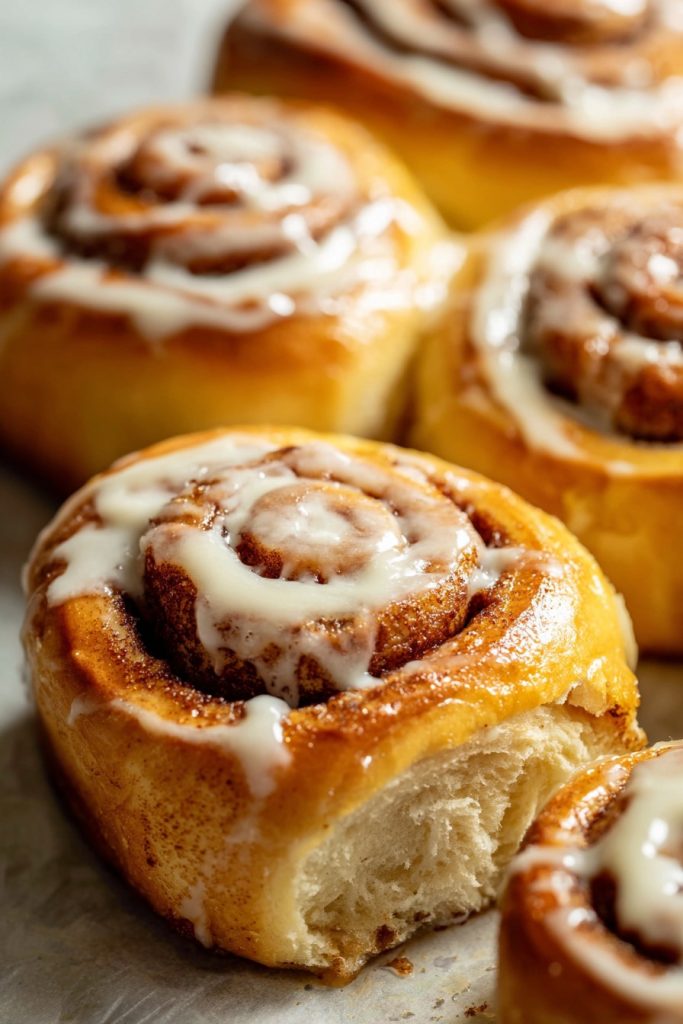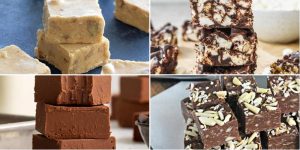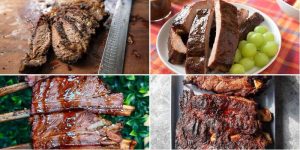Now you can enjoy warm, homemade cinnamon rolls without the lengthy dough preparation. Nothing beats the convenience of using frozen bread dough to create soft, gooey cinnamon rolls in a fraction of the time. This method delivers bakery-quality results with minimal effort, perfect for busy mornings or spontaneous treats.
Why This Recipe Works
- Using frozen bread dough eliminates the need for yeast activation, kneading, and multiple rises, cutting preparation time significantly while maintaining soft, pillowy texture
- The overnight thawing method allows the dough to develop flavor slowly in the refrigerator, resulting in better taste and texture than quick-thaw alternatives
- Rolling the dough thin ensures even cinnamon sugar distribution and creates the signature spiral layers that bake up light and tender
- Baking at 350°F provides the ideal balance between thorough cooking and maintaining moisture, preventing dry or undercooked centers
- The cream cheese frosting adds tangy contrast to the sweet filling while complementing the warm spices without overwhelming the delicate dough
Ingredients
- 1 pound frozen bread dough, thawed according to package directions
- 1/4 cup unsalted butter, softened to room temperature
- 1/2 cup granulated sugar
- 2 tablespoons ground cinnamon
- 1/4 cup brown sugar, packed
- 4 ounces cream cheese, softened to room temperature
- 1 cup powdered sugar
- 2 tablespoons whole milk
- 1 teaspoon vanilla extract
Equipment Needed
- 9×13 inch baking pan
- Rolling pin
- Pastry brush
- Mixing bowls
- Measuring cups and spoons
- Electric mixer or whisk
- Sharp knife or pastry cutter
- Parchment paper
Instructions

Prepare the Dough and Filling
Remove the frozen bread dough from freezer packaging and place it in a lightly oiled bowl. Cover the bowl with plastic wrap and refrigerate for 8-12 hours to thaw slowly. The dough should double in size and feel soft to the touch when properly thawed. While the dough rests, prepare the cinnamon sugar filling by combining 1/2 cup granulated sugar, 2 tablespoons ground cinnamon, and 1/4 cup packed brown sugar in a small bowl. Use a fork to break up any brown sugar lumps and ensure even distribution of spices. Soften 1/4 cup unsalted butter by leaving it at room temperature for 30-45 minutes until spreadable but not melted. Tip: For optimal flavor development, thaw the dough overnight in the refrigerator rather than using quick-thaw methods at room temperature.
Roll and Fill the Dough
Form the Rolls
Starting from the long edge opposite the clean border, carefully lift and roll the dough into a tight log. Use both hands to maintain even pressure while rolling, ensuring the spiral remains compact without squeezing out the filling. When you reach the clean border, pinch the seam firmly to seal the log. Position the log with the seam side down and use a sharp knife to trim about 1/2 inch from each end to create clean edges. Divide the remaining log into 12 equal pieces by making a slight indent at the 1-inch mark, then cutting straight down without sawing. Tip: Use unflavored dental floss instead of a knife for cleaner cuts that won’t compress the layers.
Arrange and Proof
Line a 9×13 inch baking pan with parchment paper, allowing some overhang on two sides for easy removal. Arrange the 12 cinnamon roll pieces in the prepared pan, spacing them evenly with about 1/2 inch between each roll. The rolls should not touch initially but will expand during proofing and baking. Cover the pan loosely with plastic wrap or a clean kitchen towel and place in a warm, draft-free area. Allow the rolls to proof for 45-60 minutes until they appear puffy and have nearly doubled in size. The rolls should spring back slowly when gently pressed with a fingertip.
Bake to Perfection
Preheat your oven to 350°F during the last 15 minutes of proofing. Once the rolls have completed proofing, remove the covering and place the pan in the center rack of the preheated oven. Bake for 20-25 minutes until the tops turn golden brown and the internal temperature reaches 190°F when measured with an instant-read thermometer. The rolls should sound hollow when tapped lightly on top. Rotate the pan halfway through baking if your oven has hot spots. Remove from oven and let cool in the pan for 10 minutes before frosting. Tip: For extra soft rolls, brush the tops with melted butter immediately after removing from the oven.
Prepare and Apply Frosting
While the rolls bake and cool, prepare the cream cheese frosting by combining 4 ounces softened cream cheese, 1 cup powdered sugar, 2 tablespoons whole milk, and 1 teaspoon vanilla extract in a medium bowl. Use an electric mixer on medium speed or a sturdy whisk to beat the ingredients until smooth and creamy, about 2-3 minutes. The frosting should be spreadable but not runny. If it appears too thick, add milk 1 teaspoon at a time. If too thin, add powdered sugar 1 tablespoon at a time. Once the rolls have cooled for 10 minutes but are still warm, spread the frosting evenly over the top using an offset spatula. The residual heat will help the frosting melt slightly into the rolls.
Tips and Tricks
For consistently perfect cinnamon rolls, consider these additional techniques beyond the basic instructions. When thawing frozen dough, the refrigerator method provides the best texture, but if you need to accelerate the process, place the sealed dough in a bowl of cold water for 2-3 hours. Never use warm water as it can kill the yeast and create dense rolls. For enhanced flavor, add 1/4 teaspoon of nutmeg or cardamom to the cinnamon sugar mixture, or incorporate 1/2 cup of finely chopped toasted pecans or walnuts into the filling.
If your kitchen is particularly cool, create a warm proofing environment by placing the covered pan in an oven with the light on or setting it near a warm appliance. The ideal proofing temperature ranges from 75°F to 85°F. To test if rolls have proofed sufficiently, they should hold a slight indentation when gently pressed and appear visibly puffed. Under-proofed rolls will be dense, while over-proofed ones may collapse during baking.
For make-ahead convenience, you can prepare the rolls through the shaping stage, then cover tightly and refrigerate for up to 24 hours. When ready to bake, remove from refrigerator and let sit at room temperature for 30 minutes before baking as directed. For freezing, bake the rolls completely, cool thoroughly, then wrap individually in plastic wrap and store in freezer bags for up to 3 months. Reheat frozen rolls in a 300°F oven for 10-15 minutes.
If your cinnamon rolls brown too quickly during baking, tent loosely with aluminum foil after the first 15 minutes. For extra gooey centers, sprinkle an additional 2 tablespoons of brown sugar in the bottom of the pan before arranging the rolls. To ensure even baking, always use a light-colored metal pan rather than glass or dark metal, which can cause over-browning. For professional presentation, wait until the rolls have cooled completely before adding frosting if you prefer a neater appearance that doesn’t melt into the rolls.
Recipe Variations
- Apple Cinnamon Rolls: Add 1 cup of finely diced peeled apples tossed with 1 tablespoon of lemon juice to the cinnamon sugar filling. The apples soften during baking and provide natural sweetness and moisture. Reduce the granulated sugar in the filling by 2 tablespoons to account for the fruit’s sweetness. This variation works particularly well with Granny Smith or Honeycrisp apples for their firm texture and tart balance.
- Orange Cardamom Rolls: Replace the vanilla extract in the frosting with 1 tablespoon of fresh orange zest and 1 teaspoon of orange extract. Add 1/2 teaspoon of ground cardamom to the cinnamon sugar mixture. The citrus notes complement the warm spices beautifully while cutting through the richness. For enhanced orange flavor, substitute orange juice for the milk in the frosting.
- Pecan Sticky Buns: Before arranging the rolls in the pan, combine 1/2 cup melted butter, 1 cup brown sugar, and 1/4 cup corn syrup in the bottom of the baking dish. Sprinkle 1 cup of chopped pecans over the mixture. Place the rolls cut-side down on top and bake as directed. After baking, immediately invert the pan onto a serving platter to reveal the caramel-glazed tops.
- Chocolate Hazelnut Rolls: Replace the cinnamon sugar filling with 1/2 cup chocolate hazelnut spread mixed with 2 tablespoons of cocoa powder. Sprinkle 1/2 cup of chopped toasted hazelnuts over the spread before rolling. The chocolate version works particularly well for dessert servings or special occasions. Consider adding a chocolate glaze instead of cream cheese frosting for maximum chocolate intensity.
- Savory Herb Rolls: For a non-sweet alternative, replace the cinnamon sugar with 1/4 cup grated Parmesan cheese, 2 tablespoons of dried Italian herbs, and 1 minced garlic clove mixed with the softened butter. Omit the frosting and instead brush the baked rolls with garlic butter. These work well as dinner rolls or alongside soups and salads.
Frequently Asked Questions
Can I use different types of frozen dough for this recipe?
Yes, while traditional white bread dough works best, you can experiment with whole wheat or honey wheat varieties. Whole wheat dough may require slightly longer proofing times due to the denser grain structure. Avoid doughs with strong flavors like garlic or herbs unless making the savory variation. Pizza dough can work in a pinch but will produce chewier rolls with less sweetness absorption. The key is ensuring the dough contains yeast and is designed to rise, rather than quick bread or pastry doughs that won’t develop the characteristic soft texture.
How do I store leftover cinnamon rolls and for how long?
Store completely cooled unfrosted rolls in an airtight container at room temperature for up to 2 days. Frosted rolls should be refrigerated and consumed within 3-4 days. To refresh day-old rolls, warm them in a 300°F oven for 5-8 minutes or microwave individual rolls for 15-20 seconds. For longer storage, freeze baked rolls without frosting for up to 3 months. Thaw frozen rolls at room temperature for 1-2 hours before warming and frosting. Never refrigerate or freeze unbaked rolls as this can damage the yeast activity and texture.
Why did my cinnamon rolls turn out dense instead of light and fluffy?
Dense cinnamon rolls typically result from insufficient proofing, over-handling the dough, or using dough that was improperly thawed. Ensure the dough proofs in a warm environment until nearly doubled in size, which usually takes 45-60 minutes. Avoid over-flouring the work surface when rolling, as excess flour can incorporate into the dough and create toughness. Also, verify your oven temperature with an independent thermometer, as baking at too low a temperature can prevent proper rise. Using dough that was thawed too quickly or refrozen can also compromise the yeast activity necessary for light texture.
Can I make these cinnamon rolls dairy-free or vegan?
Yes, with simple substitutions. Replace the butter with vegan butter or coconut oil in both the filling and pan preparation. For the frosting, use vegan cream cheese alternative and plant-based milk. Ensure your frozen bread dough doesn’t contain dairy or eggs by checking the ingredient list, as many commercial frozen doughs are accidentally vegan. The proofing and baking times remain the same with these substitutions. For egg-free concerns, most frozen bread dough doesn’t contain eggs, but always verify the packaging to be certain.
What’s the best way to achieve perfectly spiral rolls that don’t unroll during baking?
To maintain tight spirals, roll the dough firmly but gently without stretching, and ensure the final seam is securely pinched closed. Chilling the rolled log for 15-20 minutes before slicing makes cutting cleaner and helps the rolls hold their shape. When arranging in the pan, place them close enough that they’ll touch during baking, which provides support. Using a very sharp knife or dental floss prevents compressing the layers during cutting. Proper proofing is also crucial—under-proofed rolls may spring open while over-proofed ones can collapse and lose definition.
Summary
Frozen bread dough transforms into soft, homemade cinnamon rolls with minimal effort. The overnight thaw, careful rolling, and proper proofing create bakery-quality results. Customize with various fillings and frostings to suit any occasion. Perfect for busy mornings or special treats.
Cinnamon Rolls from Frozen Bread Dough
6
servings20
minutes25
minutesIngredients
Instructions
- 1 Thaw frozen dough in refrigerator for 8-12 hours until doubled in size
- 2 Combine granulated sugar, cinnamon, and brown sugar for filling
- 3 Roll dough into 12x16 inch rectangle on floured surface
- 4 Spread softened butter over dough, then sprinkle cinnamon sugar mixture
- 5 Roll dough tightly from long edge, pinch seam to seal
- 6 Cut into 12 equal pieces using sharp knife or dental floss
- 7 Arrange in parchment-lined 9x13 inch pan, cover, and proof 45-60 minutes
- 8 Bake at 350°F for 20-25 minutes until golden brown
- 9 Beat cream cheese, powdered sugar, milk, and vanilla for frosting
- 10 Spread frosting over warm rolls after 10 minutes cooling



